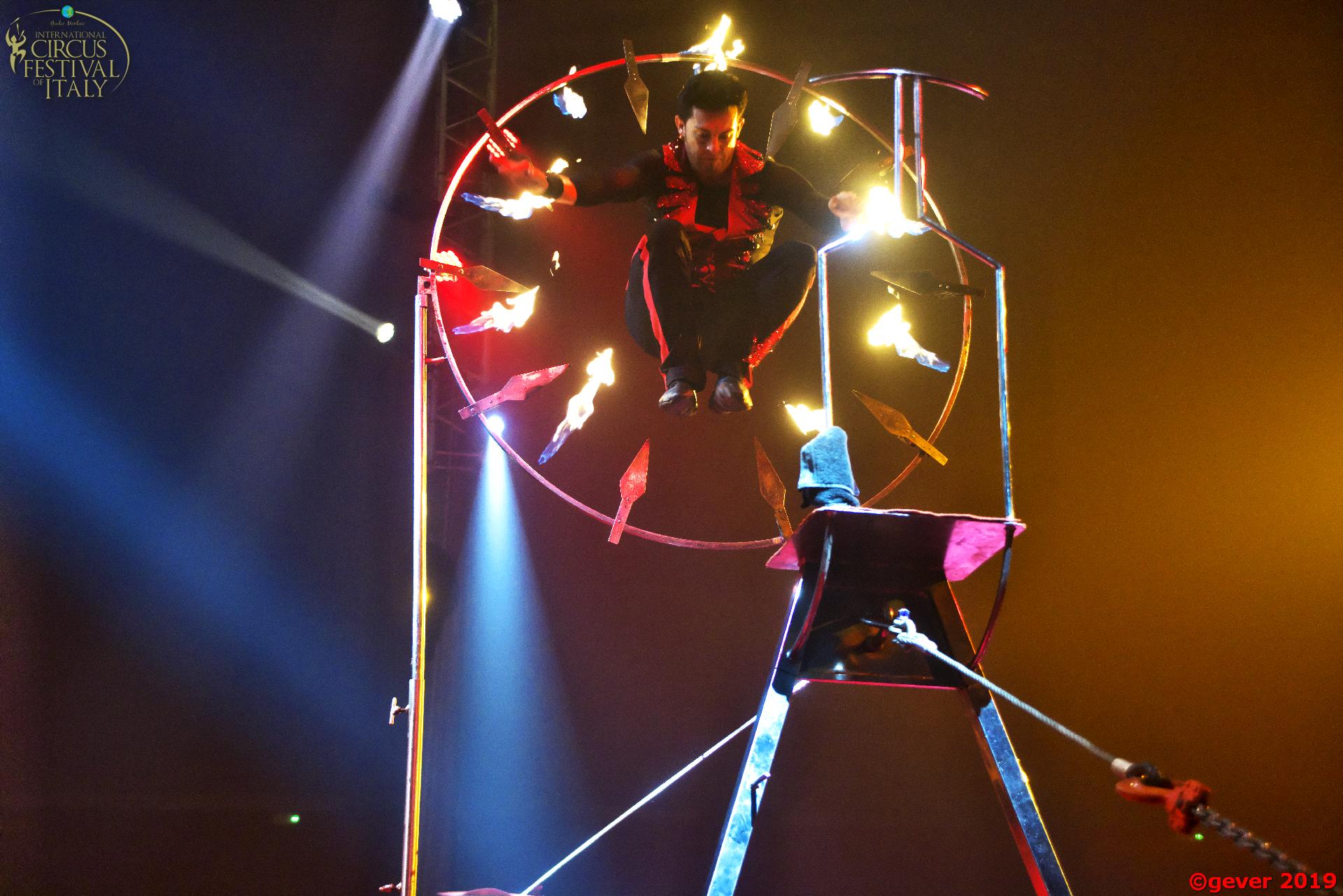Circus Immersion–Always in Balance
We’ve all walked on a fallen tree or the playground’s beam with our arms up in the air. A concentrated and graceful person crossing a wire, sometimes holding on tight to an umbrella, is one of the oldest known images worldwide. We’ve all seen it in storybooks where some intrepid animal in a tutu pretended to be a circus artist, or by the ring, popcorn in hand as our eyes gaze high up. Such familiarity is no surprise given tight wire’s constant presence in circus programs since the 1800s. Various dance styles, acrobatic prowess, and random props used by artists from all walks of life have allowed this ancient discipline to keep up with more recent ones and remain relevant throughout the years.

Audiences are likely to see a dynamic man racing from one platform to the next at a traditional Christmas circus while an elegant lady is seemingly floating above an intimate theater’s stage right across the street. A general consensus that there is no “must move” and that everyone’s style and personality are both welcomed and encouraged is present in the wire community. One’s movement quality, as well as the originality in their research and general presentation, mark the imagination and make an act memorable. At least according to Silea, Nicol Nicols, and Hannah Moisala! The first artist made a name for herself in the German cabarets while the second (Nicol) has been following his father’s footsteps in traditional circus. As for Moisala, the contemporary scene has always felt like home and where she wanted to invest herself. Together, these three cumulate nearly 80 years of jumping, turning and running… Always in balance! Or are they?
“It’s actually more about being unbalanced than balanced! More time is spent searching for your balance than being in it,” says Moisala. The former Finnish skater felt similarities between the ways her muscles and feet reacted up there as the way they did on the ice. She quickly developed a love-and-hate relationship with what she refers to as an unpredictable discipline. Just like there are no days that feel alike, each walk is bound to be different and the secret to one’s inner balance and stability has yet to be found. The Oulu native sees such reality positively as each walk brings daily surprises and discoveries. Tight wire’s unpredictable nature allows its practitioners to find and experiment with something new every day, the same way that one’s emotions and decisions can turn all plans upside down.
While training at Turku’s circus school, she quickly realized that combining skills between platforms was necessary and required a lot in order to find her own way of moving. This epiphany drew her attention to transitions, all those in-betweens where wire artists can shine by showing their personality. One must also develop their awareness of details and delicacy to understand how even the briefest slip can impact a movement that has been performed countless times.
“Such awareness drives me and keeps me on my toes at all times!” she says with both joy and defiance in her voice.

Moisala then points out that this act puts a lot of emphasis on nuances and that a still body can be the unexpected highlight. An established path of going from A to B, of crossing the same line again and again does not exist in any other discipline.
The endless debate surrounding tight wire’s nature, whether it shall be classified as ground or aerial, also adds to its uniqueness. The Finnish artist feels closer to the air despite an undeniably strong connection to those watching on the ground. One could argue that technically speaking, freestanding structures and traditional programs make it a ground act.
“One where most of the action takes place above it! Even if successfully recreating fluidity and insurance in the air requires hours of groundwork.”
The main difference between air and ground might lay in one’s soles and the way they put their feet down. Heels first hit the ground whereas toes take the lead on the wire. Pedestrians look at where they’re about to step and wire walkers are gazing far ahead, usually at the end of the wire.
“It’s a soft walk that slides. I’m taller on the street, standing straighter without keeping my knees soft as I do on the wire.” she’ll conclude.
Keeping it in the Family

Valencia-born Nicol Nicols needs a long, deep inhale and an even longer moment to recall his first circus show, but it had to be when his father and uncle were flying high above the ring. Captivated by a troupe of 11 daredevils going from one trapeze to the next in pirates’ costumes, the little boy was impressed by how huge and spectacular everything felt. Inspired by his elders, he made his professional debuts at 11 years old, juggling and doing Icarian games with his brother in a Swiss circus. Guided and somewhat challenged by the circus’ tight wire performer, he took his first steps off the ground and was instantly hooked.
“These initial walks were stressful, but I felt more challenged than in other disciplines and far more concentrated. I really enjoyed it! My father and uncle taught me everything!”
Next to the discipline’s challenging nature, Nicols suggests that the elements of dance, acrobatics, and balance that form its DNA make this act a truly complete one. However, much like his Finnish colleague, he admits to a love-and-hate relationship with the discipline. More than 30 years spent turning and jumping between platforms make it still impossible to predict how the next performance will go. The Spanish artist is however convinced that age and experience allow for style and moves to get more defined in an act that has fewer standards and marks to hit.
Having spent years performing a Latin-inspired piece in circuses and festivals like Arlette Gruss or Massy, Nicols says that seeing other artists’ moves and choreographic approach has kept him inspired and allowed him to never stagnate. He highlights once more that various elements of running, jumping, turning, and walking make a déjà-vu encounter nearly impossible when watching a tight wire act. Each artist having to find their balance and rhythm to get the moves that suit their body means that no amount of social media material makes a copy-cat possible.
“An open mind and a will to be yourself lead to endless possibilities with a stage partner that constantly challenges you” he adds in a firm yet calm voice.

On the topic of openness, the 49-year-old includes the audience and insists on the importance of opening up to them. It is not only possible but necessary to be concentrated on both the wire and the people watching. They cannot be forgotten and if they can be a source of distraction when getting up and moving around, their response to a look or smile can add lightness and strength to the next move.
“Tightwire is all about connecting. Connecting with the audience and connecting movements together to gain fluidity. You usually don’t want to stop and break this flow. When you do, it most often is to find your balance and there’s your chance to reconnect with the audience.”
Back on the ground, the former ‘wire Torrero’ wraps up by saying that walking down there is freeing in a way that one can forget what or where they are stepping on.
A Stronger Connection Defined by Who Makes the Step
If Hannah Moisala feels taller and Nicol Nicols freer walking down the street, Silea lacks a form of response to the surface she might be stepping on. Instead, “Teamwork” comes to mind when asked to describe her relationship with the wire and the biggest difference between walking up there and down below. The metallic thread responds to who steps on it. The wire defines how one approaches and reacts to each step, finds their rhythm, and whether they move with or against it. This connection between the artist and its equipment is omnipresent and bound to change as much as one’s moods and personality.
“Mine is about lightness. I just love being on it. I’m as balanced within as I appear from the outside. It also brings a great sense of freedom that makes me forget about gravity,” says the wire dancer.

Growing up in Frankfurt with an interest in gymnastics and pushing her body’s limits, she moved to Berlin to become a circus artist at the State’s ballet and circus school. Unable to decide between trapeze and tight wire, it took her a few months to realize that the latter one had opened her to a world of possibilities that kept getting bigger. The ability to transform movements from the floor to the wire remains a huge source of inspiration and a great challenge in the impassioned artist’s voice. She maintains that possibilities are endless and that her world keeps getting broader years into her practice.
Tightwire is pure art, one that defines movement by its level and use of balance, according to the woman with more than two decades of slippers and fans behind her. The possibility of falling being more present, if not an integral part of the practice makes it a more fragile one.
“It is more about trusting your feelings than being powerful. Tightwire is mind-over-muscles!” she confidently affirms.
Unlike with most circus disciplines, there is no hanging and no grounding in the traditional way. One must feel grounded without a flat surface to do so. The discipline’s hard to pin down nature, somewhere between aerial and ground, makes it nearly impossible to compare it with other acts. No one walks in the air, replicating a ground motion away from it, the way wire artists do.
Tightwire is mind-over-muscles
The personal and unique way with which someone finds their balance changes from one act to another, from one show to the next. The fact that nobody reacts the same way to losing their footing means that the same movements can be performed in two acts and feel entirely different. Silea believes that one’s reaction to losing one’s balance says a lot about their personality and that an audience is, therefore, more likely to get a glimpse of a tight wire’s artist.

Echoing Nicols’ words on how one can and should focus on both the wire and the audience, she adds that her acts are more about sharing than showing her quest for balance and that seeing her lose it can be as entertaining.
Lastly, to those who shy away from tight wire for its lack of partnering possibilities and its soloist look, the 2000s have brought several innovative concepts with collaboration and innovation at its core. The French company Les Colporteurs had seven artists sharing the same wires in Le Fil sous la Neige, Ulla Tikla and Andreas Muntwyler have created several duos with the Switzerland-based company F-ART, and a wire quartet was one of Cirque du Soleil’s Amaluna‘s highlights in 2012. Wire walkers, always in balance… And not always on their own!
All photos provided courtesy of Martin Frenette.
Related content: Circus Immersion–Wrapping Up and Dropping Down, Circus Immersion–Juggling: It’s More Than Just Throwing Objects in the Air
...Do you have a story to share? Submit your news story, article or press release.







